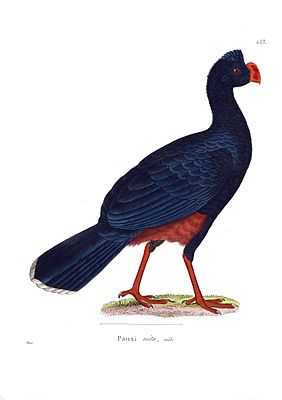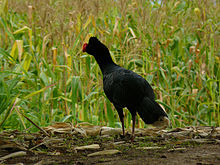Mitu (genus)
| With U | ||||||||
|---|---|---|---|---|---|---|---|---|

Mitu ( Mitu mitu ) |
||||||||
| Systematics | ||||||||
|
||||||||
| Scientific name | ||||||||
| With U | ||||||||
| Lesson , 1831 |
Mitu s ( Mitu ) are a genus of turkey-sized hokko chickens that are native to the South American rainforest . Of the four species, one species, Mitu , is extinct in the wild.
features
In contrast to the representatives of the genus Crax, Mitus have no beak wax skin and their nostrils are located on the beak root, which is feathered up to the nostrils. Short, high and strongly curved upper beaks are characteristic of mitus. Two species, namely the Mitu and the Amazonashokko , also show humps in the basal half of the upper beak. In the Samthokko ( M. tomentosa ), the upper bill is only compressed on the side surfaces.
There is no noticeable gender dimorphism in the mitus . All four species have predominantly black body plumage.
The Samthokko has a hardly elongated crown plumage. The Salvinhokko, on the other hand, has a feather hood on the top, which is formed from widened feathers with rounded ends. Basically, the crown feathers of the Minus are not ruffled as they are with the Crux species, but they are strongly iridescent and thus differ from the rest of the fine head plumage.
species
The following species belong to the mitus:
- Samthokko ( M. tomentosa )
- Salvinhokko ( M. salvini )
- Amazonashokko or Amazonas mitu ( M. tuberosa )
- Mitu ( M. mitu )
attitude
Mitus have been kept in captivity for a comparatively long time. Coenraad Jacob Temminck (1778-1858) reports on an Amazon Kokko held near The Hague. The Zoological Society of London also owned a Hokko chicken of this type before 1835. Edward Smith-Stanley, 13th Earl of Derby , also kept an Amazon Kokko in his menagerie at Knowsley Hall at the beginning of the 19th century . However, it was not until 1929 that Oskar Heinroth succeeded in rearing this species in the Berlin zoo. They are still considered to be the most frequently kept species.
Mitu, now extinct in the wild, is only kept in captivity. In 1977 the Brazilian conservationist Pedro Mario Nardelli set up a breeding station in Nilópolis near Rio de Janeiro, in which there were four in 1979, 34 in 1993 and 44 in 2000. In the following period, other Brazilian bird parks and zoos kept Mitus, so that the total population was 81 in 2003, 130 in 2008 and around 230 in 2015.
Samthokko and Salvinhokko are kept comparatively rarely. However, at the beginning of the 19th century, Lord Derby's menagerie included a velvet jacket in addition to an Amazon jacket. The first scientific description of the Salvinhokko was made in 1879 on a specimen kept in Europe. It was first bred in captivity in 1971.
literature
- ET Grau, SL Pereira, LF Silveira, A Wajntal: Molecular markers contribute to a breeding program of the extinct-in-the-wild Alagoas Curassow Mitu mitu and confirm the validity of the species . In: Bird Conservation International . tape 13 , 2003, p. 115–126 ( PDF 89 kB [accessed on May 11, 2013]).
- Luís Fábio Silveira, Fábio Olmos, Adrian J. Long: Taxonomy, history, and status of Alagoas Curassow Mitu mitu (Linnaeus, 1766), the world's most threatened cracid . In: Ararajuba . tape 12 , no. 2 , 2004, p. 125–132 ( PDF, 84kB [accessed on May 11, 2013]).
- Heinz-Sigurd Raethel : Chicken birds of the world. Natur Verlag, Weltbild Verlag, Augsburg 1991, ISBN 3-89440-440-X .
Single receipts
- ↑ Raethel: Chicken Birds of the World . P. 94.
- ↑ Raethel: Chicken Birds of the World . P. 96.
- ↑ Raethel: Chicken Birds of the World . P. 95.
